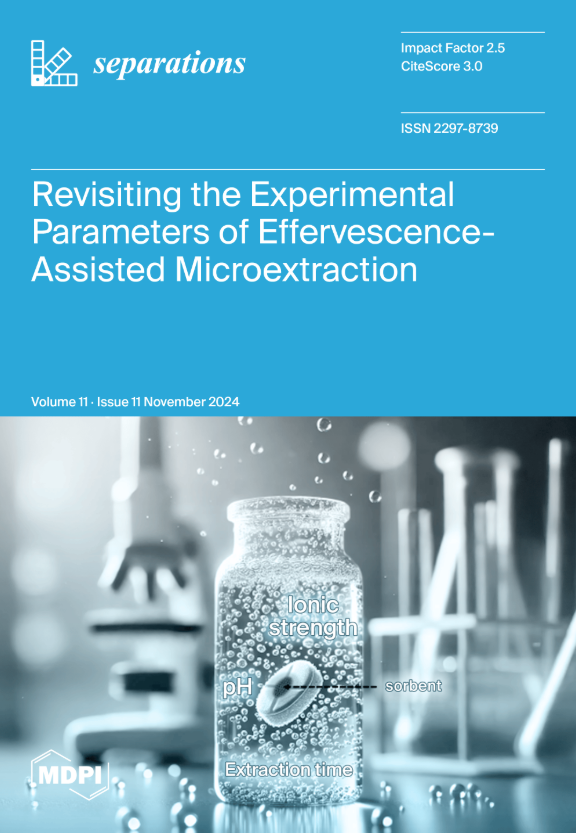LC/MS-Based Profiling of Hedyotis aspera Whole-Plant Methanolic Extract and Evaluation of Its Nephroprotective Potential against Gentamicin-Induced Nephrotoxicity in Rats Supported by In Silico Studies
IF 2.7
4区 工程技术
Q3 CHEMISTRY, ANALYTICAL
引用次数: 0
Abstract
Many high-altitude plants, such as Hedyotis aspera, need to be explored for their possible medicinal value. The current study explored the protective effect of Hedyotis aspera methanolic extract whole plant (HAME) against gentamicin-induced nephrotoxicity in rats. It profiled their phytocontents using HPLC-QTOF-MS/MS analytic methods. The LC-MS analysis of HAME revealed 27 compounds. Eight compounds followed Lipinski’s rule of five and were found to be potential TNF-α inhibitors with binding affinities of −6.9, −6.3, −6.3, and −6.3 Kcal/mol, such as 14,19-Dihydroaspidospermatine, coumeroic acid, lycocernuine and muzanzagenin. All potential compounds were found to be safe according to the ADMET analysis. The in vitro 2,2-diphenyl-1-picrlhydrazyl (DPPH) assay assessed the antioxidant activity. The nephroprotective activity was assessed in rats using a gentamicin-induced nephrotoxicity model. The in vivo analysis involved histological examination, tissue biochemical evaluation, including a kidney function test, catalase activity (CAT), reduced glutathione (GSH) levels, superoxide dismutase (SOD), and the inflammatory mediator TNF-α. Based on DPPH activity, HAME showed a scavenging activity IC50 of 264.8 ± 1.2 µg/mL, while results were compared with a standard vitamin C IC50 of 45 ± 0.45 µg/mL. Nephrotoxicity was successfully induced, as shown by elevated creatinine and uric acid levels, decreased kidney antioxidant levels, and increased TNF-α in gentamicin-treated rats. The HAME treatment significantly reduced serum creatinine and uric acid levels, increased GSH (p < 0.01 **), CAT (p < 0.01 **), and SOD (p < 0.001 ***), and decreased TNF-α (p < 0.001 ***) in nephrotoxic rats. The histopathological examination of the groups treated with HAME revealed a notable enhancement in the structural integrity of the kidneys as compared to the group exposed to gentamicin. Biochemical, histopathological, and phytochemical screening of HAME suggests that it has nephroprotective potential, owing to the presence of 14,19-Dihydroaspidospermatine, coumeroic acid, lycopene, and muzanzagenin.基于LC/ ms的大鼠蛇尾草全植物甲醇提取物分析及其抗庆大霉素肾毒性的肾保护作用
许多高海拔植物,如蛇舌草(Hedyotis aspera),需要探索其可能的药用价值。本研究探讨了蛇舌草甲醇提取物(HAME)对庆大霉素致大鼠肾毒性的保护作用。采用HPLC-QTOF-MS/MS分析方法对其植物成分进行了分析。LC-MS分析发现27个化合物。八种化合物符合Lipinski的五法则,被发现是潜在的TNF-α抑制剂,其结合亲和力为- 6.9,- 6.3,- 6.3和- 6.3 Kcal/mol,如14,19-二氢aspidospermatine,香豆酸,番茄素和muzanzagenin。根据ADMET的分析,所有潜在的化合物都是安全的。体外2,2-二苯基-1-苦酰肼(DPPH)测定抗氧化活性。用庆大霉素肾毒性模型评估大鼠肾保护活性。体内分析包括组织学检查、组织生化评估,包括肾功能测试、过氧化氢酶活性(CAT)、还原型谷胱甘肽(GSH)水平、超氧化物歧化酶(SOD)和炎症介质TNF-α。根据DPPH活性,HAME的IC50为264.8±1.2µg/mL,而标准维生素C的IC50为45±0.45µg/mL。庆大霉素处理的大鼠肾毒性被成功诱导,表现为肌酐和尿酸水平升高,肾脏抗氧化水平降低,TNF-α升高。HAME治疗显著降低血清肌酐和尿酸水平,升高谷胱甘肽(p <0.01 **), CAT (p <0.01 **), SOD (p <0.001 ***), TNF-α降低(p <0.001 ***)。用HAME治疗组的组织病理学检查显示,与使用庆大霉素组相比,肾脏的结构完整性显著增强。HAME的生化、组织病理学和植物化学筛选表明,由于其含有14,19-二氢aspidosperine、香豆酸、番茄红素和muzanzenin, HAME具有肾保护潜力。
本文章由计算机程序翻译,如有差异,请以英文原文为准。
求助全文
约1分钟内获得全文
求助全文
来源期刊

Separations
Chemistry-Analytical Chemistry
CiteScore
3.00
自引率
15.40%
发文量
342
审稿时长
12 weeks
期刊介绍:
Separations (formerly Chromatography, ISSN 2227-9075, CODEN: CHROBV) provides an advanced forum for separation and purification science and technology in all areas of chemical, biological and physical science. It publishes reviews, regular research papers and communications. Our aim is to encourage scientists to publish their experimental and theoretical results in as much detail as possible. There is no restriction on the length of the papers. The full experimental details must be provided so that the results can be reproduced. There are, in addition, unique features of this journal:
Manuscripts regarding research proposals and research ideas will be particularly welcomed.
Electronic files and software regarding the full details of the calculation and experimental procedure, if unable to be published in a normal way, can be deposited as supplementary material.
Manuscripts concerning summaries and surveys on research cooperation and projects (that are funded by national governments) to give information for a broad field of users.
The scope of the journal includes but is not limited to:
Theory and methodology (theory of separation methods, sample preparation, instrumental and column developments, new separation methodologies, etc.)
Equipment and techniques, novel hyphenated analytical solutions (significantly extended by their combination with spectroscopic methods and in particular, mass spectrometry)
Novel analysis approaches and applications to solve analytical challenges which utilize chromatographic separations as a key step in the overall solution
Computational modelling of separations for the purpose of fundamental understanding and/or chromatographic optimization
 求助内容:
求助内容: 应助结果提醒方式:
应助结果提醒方式:


